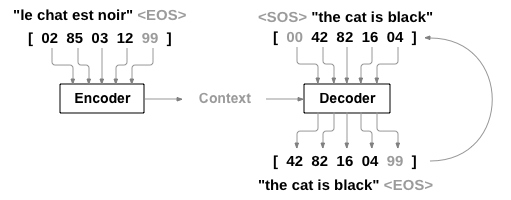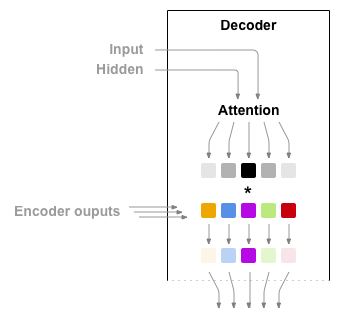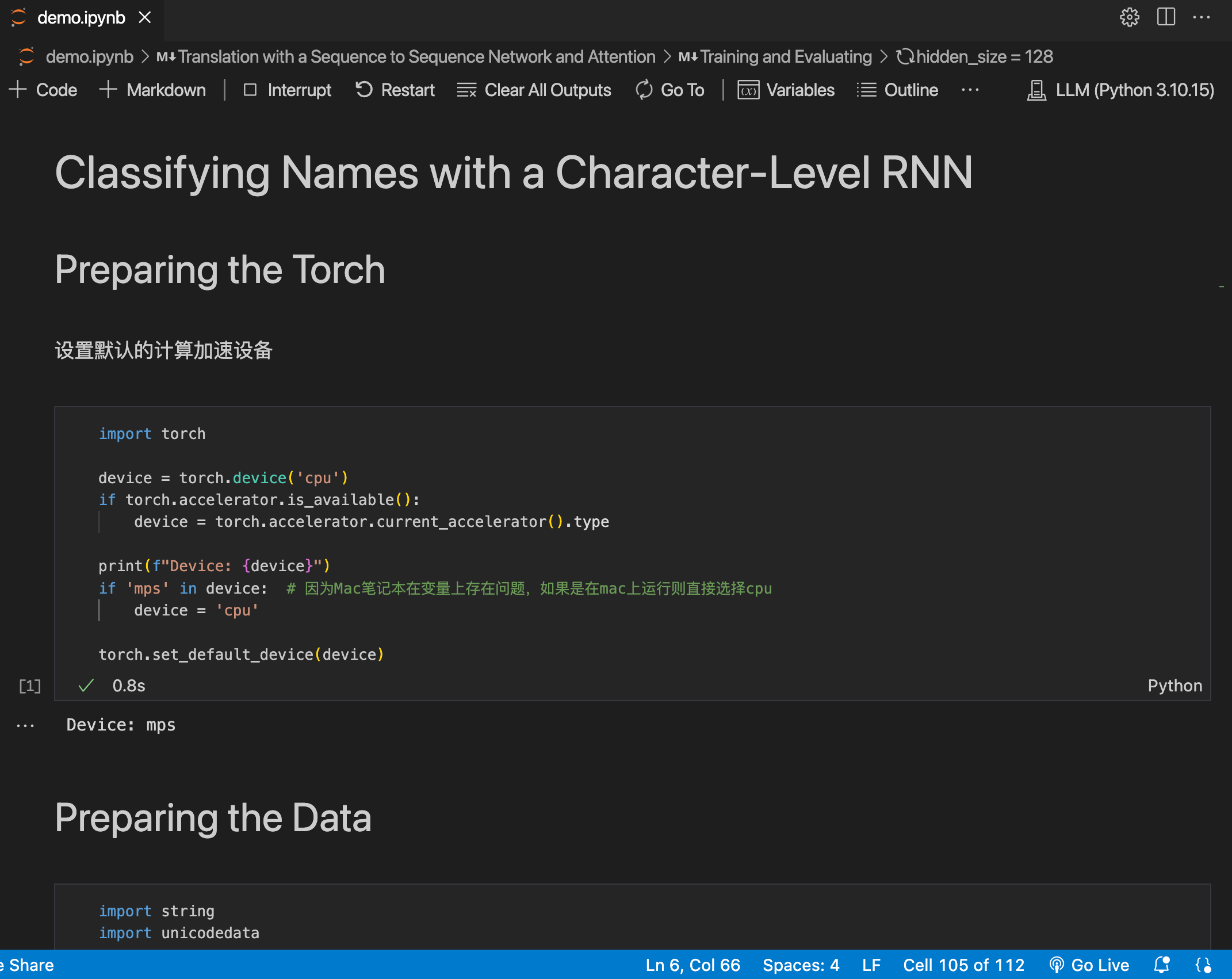这篇博客瞄准的是 pytorch 官方教程中 Learning PyTorch 章节的 NLP from Scratch 部分。
python
完整网盘链接: https://pan.baidu.com/s/1L9PVZ-KRDGVER-AJnXOvlQ?pwd=aa2m 提取码: aa2m 这篇教程中主要包含了三个例子:
- Classifying Names with a Character-Level RNN
- Generating Names with a Character-Level RNN
- Translation with a Sequence to Sequence Network and Attention
Classifying Names with a Character-Level RNN
这篇文章将构建和训练一个基本的字符级循环神经网络 (RNN) 来对单词进行分类,展示了如何预处理数据以对 NLP 进行建模。字符级 RNN 将单词读取为一系列字符 - 在每个步骤输出预测和"隐藏状态",将其先前的隐藏状态输入到下一步,最终预测作为输出,即单词属于哪个类。
官网在这里推荐了两个知识拓展链接:
Preparing Torch
设置默认的计算加速设备
python
import torch
device = torch.device('cpu')
if torch.accelerator.is_available():
device = torch.accelerator.current_accelerator().type
torch.set_default_device(device)
print(f"Device: {device}")Preparing the Data
首先从 链接 中下载数据,下载后将其就地解压。data/names 中包含 18 个文本文件,名为 [Language].txt。每个文件包含一堆名称,每行一个名称。
首先,将 Unicode 转换为纯 ASCII 以限制 RNN 输入层。
python
import string
import unicodedata
allowed_characters = string.ascii_letters + " .,;'" + "_"
n_letters = len(allowed_characters)
def unicodeToAscii(s):
return ''.join(
c for c in unicodedata.normalize('NFD', s)
if unicodedata.category(c) != 'Mn'
and c in allowed_characters
)
print (f"converting 'Ślusàrski' to {unicodeToAscii('Ślusàrski')}")Turning Names into Tensors
现在需要将字符串转换成Tensor才能使用。为了表示单个字母,用大小为 <1 x n_letters> 的"one-hot vector"。除了字母索引处的值为1,one-hot 向量的其他位置填充了 0,例如"b"= <0 1 0 0 0 ...>;为了组成一个单词,将一堆字母合并成一个二维矩阵 <line_length x 1 x n_letters>。额外的 1 个维度是因为 PyTorch 假设所有内容都是批量的,这里只使用 1 的批量大小。
定义字符转index与字母转matrix函数
python
# 字符转index
def letterToIndex(letter):
if letter not in allowed_characters:
return allowed_characters.find('_')
else:
return allowed_characters.find(letter)
# 字母转matrix
def lineToTensor(line):
tensor = torch.zeros(len(line), 1, n_letters)
for li, letter in enumerate(line):
tensor[li][0][letterToIndex(letter)] = 1
return tensor查看case
python
print (f"The letter 'a' becomes {lineToTensor('a')}") #notice that the first position in the tensor = 1
print (f"The name 'Ahn' becomes {lineToTensor('Ahn')}") #notice 'A' sets the 27th index to 1接下来需要将所有case组合成一个数据集。使用 Dataset 和 DataLoader 类来保存数据集,每个 Dataset 都需要实现三个函数:__init__、__len__ 和 __getitem__。
定义Dataset
python
class NamesDataset(Dataset):
def __init__(self, data_dir):
# super().__init__()
self.data_dir = data_dir
self.load_time = time.localtime
labels_set = set()
self.data = []
self.data_tensors = []
self.labels = []
self.labels_tensors = []
text_files = glob.glob(os.path.join(data_dir, '*.txt'))
for filename in text_files:
label = os.path.splitext(os.path.basename(filename))[0]
labels_set.add(label)
lines = open(filename, encoding='utf-8').read().strip().split('\n')
for name in lines:
self.data.append(name)
self.data_tensors.append(lineToTensor(name))
self.labels.append(label)
self.labels_uniq = list(labels_set)
for idx in range(len(labels_set)):
tmp_tensor = torch.tensor([self.labels_uniq.index(self.labels[idx])], dtype=torch.long)
self.labels_tensors.append(tmp_tensor)
def __len__(self):
return len(self.data)
def __getitem__(self, idx):
data_item = self.data[idx]
data_label = self.labels[idx]
data_tensor = self.data_tensors[idx]
label_tensor = self.labels_tensors[idx]
return label_tensor, data_tensor, data_label, data_item加载数据
python
alldata = NamesDataset("data/names")
print(f"Loaded: {len(alldata)}")
print(f"example: {alldata[0]}")将数据集拆分成训练集与测试集合
python
train_set, test_set = torch.utils.data.random_split(alldata, [0.85, 0.15], generator=torch.Generator(device=device).manual_seed(2025))
# generator = torch.Generator(device=device).manual_seed(2025) # 官网写法从在bug
print(f"Len train set {len(train_set)}; Len test set {len(test_set)}")Creating the Network
在 autograd 之前,Torch 中创建RNN时络涉及从多个 timestep 中克隆一个层的参数。这些层保存隐藏状态和梯度,现在完全由图本身处理。
下面这个 CharRNN 类实现了一个包含三个组件的 RNN。使用 nn.RNN 实现,定义一个将 RNN 隐藏层映射到输出的层,最后应用 softmax 函数。与将每个层均为 nn.Linear 相比,使用 nn.RNN 可以显著提高性能。
python
import torch.nn as nn
import torch.nn.functional as f
class CharRNN(nn.Module):
def __init__(self, input_size, hidden_size, output_size):
super(CharRNN, self).__init__()
self.rnn = nn.RNN(input_size, hidden_size)
self.h2o = nn.Linear(hidden_size, output_size)
self.softmax = nn.LogSoftmax(dim=1)
def forward(self, line_tensor):
rnn_out, hidden = self.rnn(line_tensor)
output = self.h2o(hidden[0])
output = self.softmax(output)
return output创建一个具有 58 个输入节点、128 个隐藏节点和 18 个输出的 RNN:
python
n_hidden = 128
rnn =CharRNN(n_letters, n_hidden, len(alldata.labels_uniq))
print(rnn)将 Tensor 传递给 RNN 以获得预测输出,使用辅助函数 label_from_output 为该类导出文本标签。
python
def label_from_output(output, output_labels):
top_n, top_i = output.topk(1)
label_i = top_i[0].item()
return output_labels[label_i], label_i
input = lineToTensor('Albert')
output = rnn(input)
print(output)
print(label_from_output(output, alldata.labels_uniq))Training
定义一个 train() 函数,该函数使用小批量在给定数据集上训练模型。RNN 的训练方式与其他网络类似,循环在调整权重之前计算批次中每个项目的损失,直到达到 epoch 数。
定义train函数
python
import random
import numpy as np
def train(rnn, training_data, n_epochs=10, n_batch_size=64, report_every=50, learning_rate=0.2, criterion=nn.NLLLoss()):
current_loss = 0
all_losses = []
rnn.train()
rnn.to(device)
optimizer = torch.optim.SGD(rnn.parameters(), lr=learning_rate,)
print(f"Trainint with data size={len(training_data)}")
for iter in range(1, n_epochs+1):
rnn.zero_grad()
batchs = list(range(len(training_data)))
random.shuffle(batchs)
batchs = np.array_split(batchs, len(batchs) // n_batch_size)
for idx, batch in enumerate(batchs):
batch_loss = 0
for i in batch:
(label_tensor, text_tensor, label, text) = training_data[i]
output = rnn.forward(text_tensor)
loss = criterion(output, label_tensor)
batch_loss += loss
batch_loss.backward()
nn.utils.clip_grad_norm_(rnn.parameters(), 3)
optimizer.step()
optimizer.zero_grad()
current_loss += batch_loss.item() / len(batch)
all_losses.append(current_loss / len(batchs))
if iter % report_every == 0:
print(f"{iter} ({iter / n_epochs:.0%}): \t average batch loss = {all_losses[-1]}")
current_loss = 0
return all_losses执行训练
python
start = time.time()
all_losses = train(rnn, train_set, n_epochs=27, learning_rate=0.15, report_every=5)
end = time.time()
print(f"Training took {end-start}s")Plotting the Results
python
import matplotlib.pyplot as plt
import matplotlib.ticker as ticker
plt.figure()
plt.plot(all_losses)
plt.show()Evaluating the Results
为了查看网络在不同类别上的表现创建一个混淆矩阵,指出每种实际语言(行)对应的网络猜测的语言(列)。
python
def evaluate(rnn, testing_data, classes):
confusion = torch.zeros(len(classes), len(classes))
rnn.eval()
with torch.no_grad():
for i in range(len(testing_data)):
(label_tensor, test_tensor, label, text) = testing_data[i]
output = rnn(test_tensor)
guess, guess_i = label_from_output(output, classes)
label_i = classes.index(label)
confusion[label_i][guess_i] += 1
for i in range(len(classes)):
denom = confusion[i].sum()
if denom > 0:
confusion[i] = confusion[i] / denom
fig = plt.figure()
ax = fig.add_subplot(111)
cax = ax.matshow(confusion.cpu().numpy())
fig.colorbar(cax)
ax.set_xticks(np.arange(len(classes)), labels=classes, rotation=90)
ax.set_yticks(np.arange(len(classes)), labels=classes)
ax.xaxis.set_major_locator(ticker.MultipleLocator(1))
ax.yaxis.set_major_locator(ticker.MultipleLocator(1))
plt.show()绘制混淆矩阵
python
evaluate(rnn, test_set, classes=alldata.labels_uniq)Generating Names with a Character-Level RNN
这次将反过来根据语言生成姓名。
仍创建一个包含几个线性层的小型 RNN。最大的区别在于,不是在读完一个名字后预测类别,而是输入一个类别并一次输出一个字母,循环预测字符以形成语言,通常被称为"语言模型"
Preparing the Data
这里使用的数据与上一个case中使用的一样,所有不用二次下载,直接进入数据预处理阶段。
python
from io import open
import glob
import os
import unicodedata
import string
all_letters = string.ascii_letters + " .,;'-"
n_letters = len(all_letters) + 1
def findFiles(path):
return glob.glob(path)
def readLines(filename):
with open(filename, encoding='utf-8') as some_file:
return [unicodeToAscii(line.strip()) for line in some_file]定义 unicode 转 Ascii
python
def unicodeToAscii(s):
return ''.join(
c for c in unicodedata.normalize('NFD', s)
if unicodedata.category(c) != 'Mn'
and c in all_letters
)构建类别字典
python
category_lines = {}
all_categories = []
for filename in findFiles('data/names/*.txt'):
category = os.path.splitext(os.path.basename(filename))[0]
all_categories.append(category)
lines = readLines(filename)
category_lines[category] = lines
n_categories = len(all_categories)
if n_categories == 0:
raise RuntimeError('Data not found. Make sure that you downloaded data '
'from https://download.pytorch.org/tutorial/data.zip and extract it to '
'the current directory.')
print('# categories:', n_categories, all_categories)
print(unicodeToAscii("O'Néàl"))Creating the Network
该网络扩展了上一个教程的 RNN,为类别Tensor添加了一个额外的参数。类别Tensor与字母输入一样,是一个one-hot vector。
将输出解释为下一个字母的概率,采样时最可能的输出字母将用作下一个输入字母。添加第二个线性层 o2o(在结合隐藏层和输出层之后);还有一个 dropout 层,它以给定的概率(此处为 0.1)随机将其输入的部分归零,通常用于模糊输入以防止过度拟合。在网络末端使用它来故意增加一些混乱并增加采样多样性。

python
import torch
import torch.nn as nn
class RNN(nn.Module):
def __init__(self, input_size, hidden_size, output_size):
super(RNN, self).__init__()
self.hidden_size = hidden_size
self.i2h = nn.Linear(n_categories + input_size + hidden_size, hidden_size)
self.i2o = nn.Linear(n_categories + input_size + hidden_size, output_size)
self.o2o = nn.Linear(hidden_size + output_size, output_size)
self.dropout = nn.Dropout(0.1)
self.softmax = nn.LogSoftmax(dim=1)
def forward(self, category, input, hidden):
input_combine = torch.cat((category, input, hidden), 1)
hidden = self.i2h(input_combine)
output = self.i2o(input_combine)
output_combined = torch.cat((hidden, output), 1)
output = self.o2o(output_combined)
output = self.dropout(output)
output = self.softmax(output)
return output, hidden
def initHidden(self):
return torch.zeros(1, self.hidden_size)Training
训练的数据是一个 (category, line) 的二元组。
python
import random
def randomChoice(l):
return l[random.randint(0, len(l) - 1)]
def randomTrainingPair():
category = randomChoice(all_categories)
line = randomChoice(category_lines[category])
return category, line对于每个 timestep(即训练单词中的每个字母),网络的输入是(category, current letter, hidden state),输出是 (next letter, next hidden state)。
由于每个timestep中根据当前字母预测下一个字母,因此字母对是来自该行的连续字母组 - 例如 "ABCD<EOS>",需要创建("A","B"), ("B","C"), ("C","D"), ("D","EOS")。
类别Tensor是大小为<1 x n_categories> 的one-hot Tensor。训练时,在每个timestep将其输入到网络作为初始隐藏状态的一部分或某种其他策略。
python
def categoryTensor(category):
li = all_categories.index(category)
tensor = torch.zeros(1, n_categories)
tensor[0][li] = 1
return tensor
def inputTensor(line):
tensor = torch.zeros(len(line), 1, n_letters)
for li in range(len(line)):
letter = line[li]
tensor[li][0][all_letters.find(letter)] = 1
return tensor
def targetTensor(line):
letter_indexes = [all_letters.find(line[li]) for li in range(1, len(line))]
letter_indexes.append(n_letters - 1) # EOS
return torch.LongTensor(letter_indexes)为了训练时的方便,创建一个 randomTrainingExample 函数,它获取随机(category, line) 对并将它们转换为所需的 (category, input, target) Tensor。
python
def randomTrainingExample():
category, line = randomTrainingPair()
category_tensor = categoryTensor(category)
input_line_tensor = inputTensor(line)
target_line_tensor = targetTensor(line)
return category_tensor, input_line_tensor, target_line_tensor定义训练函数
python
criterion = nn.NLLLoss()
learning_rate = 5e-4
def train(category_tensor, input_line_tensor, target_line_tensor):
target_line_tensor.unsqueeze_(-1)
hidden = rnn.initHidden()
rnn.zero_grad()
loss = torch.Tensor([0])
for i in range(input_line_tensor.size(0)):
output, hidden = rnn(category_tensor, input_line_tensor[0], hidden)
l = criterion(output, target_line_tensor[i])
loss += l
loss.backward()
for p in rnn.parameters():
p.data.add_(p.grad.data, alpha=-learning_rate)
return output, loss.item() / input_line_tensor.size(0)执行训练
python
rnn = RNN(n_letters, 128, n_letters)
n_iters = 10000
print_every = 500
plot_every = 100
all_losses = []
total_loss = 0
start = time.time()
for iter in range(1, n_iters + 1):
output, loss = train(*randomTrainingExample())
total_loss += loss
if iter % print_every == 0:
print('%s (%d %d%%) %.4f' % (timeSince(start), iter, iter / n_iters * 100, loss))
if iter % plot_every == 0:
all_losses.append(total_loss / plot_every)
total_loss = 0绘制loss曲线
python
import matplotlib.pyplot as plt
plt.figure()
plt.plot(all_losses)Sampling the Network
给网络一个字母并询问下一个字母是什么,将其作为下一个字母输入,并重复直到 EOS。
- 为输入类别、起始字母和空隐藏状态创建Tensor;
- 使用起始字母创建一个字符串
output_name; - 最大输出长度
- 将当前字母输入网络;
- 从最高输出和下一个隐藏状态获取下一个字母;
- 如果字母是
EOS,则在此处停止; - 如果是普通字母,则添加到
output_name并继续;
- 返回最终名称
定义预测单个字符的函数
python
max_length = 20
def sample(category, start_letter='A'):
with torch.no_grad():
category_tensor = categoryTensor(category)
input = inputTensor(start_letter)
hidden = rnn.initHidden()
output_name = start_letter
for i in range(max_length):
output, hidden = rnn(category_tensor, input[0], hidden)
topv, topi = output.topk(1)
topi = topi[0][0]
if topi == n_letters - 1:
break
else:
letter = all_letters[topi]
output_name += letter
input = inputTensor(letter)
return output_name定义预测连续字符的函数
python
def samples(category, start_letters='ABC'):
for start_letter in start_letters:
print(sample(category, start_letter))执行推理
python
samples('Russian', 'RUS')
samples('German', 'GER')
samples('Spanish', 'SPA')
samples('Chinese', 'CHI')Translation with a Sequence to Sequence Network and Attention
在这个case中,将搭建一个神经网络将法语翻译成英语。
通过简单但强大的 sequence to sequence network, 网络实现的,其中两个RNN共同将一个序列转换为另一个序列。编码器网络将输入序列压缩为向量,解码器网络将该向量展开为新序列。

为了改进这个模型将使用注意力机制,让解码器学会关注输入序列的特定范围。
Requirements
python
from __future__ import unicode_literals, print_function, division
from io import open
import unicodedata
import re
import random
import torch
import torch.nn as nn
from torch import optim
import torch.nn.functional as F
import numpy as np
from torch.utils.data import TensorDataset, DataLoader, RandomSampler
device = torch.device("cuda" if torch.cuda.is_available() else "cpu")Loading data files
从这个 链接 中下载该case需要用到的数据,下载好后原地解压。
与字符级 RNN 使用的字符编码类似,将语言中的每个单词表示为一个one-hot vector,或者除了单个 1(在单词的索引处)之外的全为零的巨型向量。与语言中可能存在的数十个字符相比,单词的数量要多得多,因此编码向量要大得多。不过可以将数据修剪为每种语言仅使用几千个单词。

需要每个单词都有一个唯一索引,以便稍后用作网络的输入和目标。为了跟踪这些对象,这里使用一个名为 Lang 的辅助类,它有单词 → 索引 (word2index) 和索引 → 单词 (index2word) 词典,以及每个单词的计数 word2count,用于替换罕见单词。
python
SOS_token = 0
EOS_token = 1
class Lang:
def __init__(self, name):
self.name = name
self.word2index = {}
self.word2count = {}
self.index2word = {0: "SOS", 1: "EOS"}
self.n_words = 2 # Count SOS and EOS
def addSentence(self, sentence):
for word in sentence.split(' '):
self.addWord(word)
def addWord(self, word):
if word not in self.word2index:
self.word2index[word] = self.n_words
self.word2count[word] = 1
self.index2word[self.n_words] = word
self.n_words += 1
else:
self.word2count[word] += 1将unicode编码成ascii
python
def unicodeToAscii(s):
return ''.join(
c for c in unicodedata.normalize('NFD', s)
if unicodedata.category(c) != 'Mn'
)
def normalizeString(s):
s = unicodeToAscii(s.lower().strip())
s = re.sub(r"([.!?])", r" \1", s)
s = re.sub(r"[^a-zA-Z!?]+", r" ", s)
return s.strip()为了读取数据文件,文件拆分成行然后将行拆分成对。这些文件都是英语 → 其他语言,如果想从其他语言 → 英语进行翻译,需要添加反向标志来反转对。
python
def readLangs(lang1, lang2, reverse=False):
print("Reading lines...")
lines = open('data/%s-%s.txt' % (lang1, lang2), encoding='utf-8').\
read().strip().split('\n')
pairs = [[normalizeString(s) for s in l.split('\t')] for l in lines]
if reverse:
pairs = [list(reversed(p)) for p in pairs]
input_lang = Lang(lang2)
output_lang = Lang(lang1)
else:
input_lang = Lang(lang1)
output_lang = Lang(lang2)
return input_lang, output_lang, pairs想要快速训练,需要将数据集精简为相对较短且简单的句子。这里的最大长度是 10 个单词(包括结尾标点符号),并筛选出翻译为"I am"或"He is"等形式的句子(考虑到先前替换的撇号)。
python
MAX_LENGTH = 10
eng_prefixes = (
"i am ", "i m ",
"he is", "he s ",
"she is", "she s ",
"you are", "you re ",
"we are", "we re ",
"they are", "they re "
)
def filterPair(p):
return len(p[0].split(' ')) < MAX_LENGTH and \
len(p[1].split(' ')) < MAX_LENGTH and \
p[1].startswith(eng_prefixes)
def filterPairs(pairs):
return [pair for pair in pairs if filterPair(pair)]上面整个准备数据的过程如下:
- 读取文本文件并拆分成行,将行拆分成对;
- 规范化文本,按长度和内容进行过滤;
- 根据句子成对制作单词列表;
加载数据
python
def prepareData(lang1, lang2, reverse=False):
input_lang, output_lang, pairs = readLangs(lang1, lang2, reverse)
print("Read %s sentence pairs" % len(pairs))
pairs = filterPairs(pairs)
print("Trimmed to %s sentence pairs" % len(pairs))
print("Counting words...")
for pair in pairs:
input_lang.addSentence(pair[0])
output_lang.addSentence(pair[1])
print("Counted words:")
print(input_lang.name, input_lang.n_words)
print(output_lang.name, output_lang.n_words)
return input_lang, output_lang, pairs
input_lang, output_lang, pairs = prepareData('eng', 'fra', True)
print(random.choice(pairs))The Seq2Seq Model
RNN 是一种对序列进行操作并使用其自身输出作为后续步骤输入的网络。seq2seq 网络是一种由两个 RNN组成的模型,编码器读取输入序列并输出单个向量,解码器读取该向量以生成输出序列。

与使用单个 RNN 进行序列预测(每个输入对应一个输出)不同,seq2seq 模型摆脱了序列长度和顺序的束缚,成为两种语言之间翻译的理想选择。
例如句子 Je ne suis pas le chat noir → I am not the black cat。输入句子中的大多数单词在输出句子中都有直接翻译,但顺序略有不同,例如 chat noir 和 black cat。由于 ne/pas 结构,输入句子中还有一个单词,直接从输入单词序列生成正确的翻译会很困难。
使用 seq2seq 模型,编码器会创建一个向量,在理想情况下该向量将输入序列的"含义"编码为一个向量(句子的某个 N 维空间中的单个点)。
The Encoder
seq2seq 网络的编码器是一个 RNN,它为输入句子中的每个单词输出一些值。对于每个输入单词,编码器都会输出一个向量和一个隐藏状态,并将隐藏状态用于下一个输入单词。

python
class EncoderRNN(nn.Module):
def __init__(self, input_size, hidden_size, dropout_p=0.1):
super(EncoderRNN, self).__init__()
self.hidden_size = hidden_size
self.embedding = nn.Embedding(input_size, hidden_size)
self.gru = nn.GRU(hidden_size, hidden_size, batch_first=True)
self.dropout = nn.Dropout(dropout_p)
def forward(self, input):
embedded = self.dropout(self.embedding(input))
output, hidden = self.gru(embedded)
return output, hiddenThe Decoder
最简单的解码器是一个 RNN,用编码器输出向量并输出单词序列来创建翻译。
在最简单的 seq2seq 解码器中,仅使用编码器的最后一个输出。这个最后的输出有时被称为上下文向量,因为它对整个序列的上下文进行编码。此上下文向量用作解码器的初始隐藏状态。
在解码的每一步,解码器都会获得一个输入标记和隐藏状态。初始输入标记是字符串开头的 <SOS> 标记,第一个隐藏状态是上下文向量(编码器的最后一个隐藏状态)。

python
class DecoderRNN(nn.Module):
def __init__(self, hidden_size, output_size):
super(DecoderRNN, self).__init__()
self.embedding = nn.Embedding(output_size, hidden_size)
self.gru = nn.GRU(hidden_size, hidden_size, batch_first=True)
self.out = nn.Linear(hidden_size, output_size)
def forward(self, encoder_outputs, encoder_hidden, target_tensor=None):
batch_size = encoder_outputs.size(0)
decoder_input = torch.empty(batch_size, 1, dtype=torch.long, device=device).fill_(SOS_token)
decoder_hidden = encoder_hidden
decoder_outputs = []
for i in range(MAX_LENGTH):
decoder_output, decoder_hidden = self.forward_step(decoder_input, decoder_hidden)
decoder_outputs.append(decoder_output)
if target_tensor is not None:
decoder_input = target_tensor[:, i].unsqueeze(1)
else:
_, topi = decoder_output.topk(1)
decoder_input = topi.squeeze(-1).detach()
decoder_outputs = torch.cat(decoder_outputs, dim=1)
decoder_outputs = F.log_softmax(decoder_outputs, dim=-1)
return decoder_outputs, decoder_hidden, None
def forward_step(self, input, hidden):
output = self.embedding(input)
output = F.relu(output)
output, hidden = self.gru(output, hidden)
output = self.out(output)
return output, hiddenAttention Decoder
如果在编码器和解码器之间只传递上下文向量,那么这个单一向量就承担了编码整个句子的负担。
注意力机制允许解码器网络在解码器自身输出的每一步中"关注"编码器输出的不同部分。首先,计算一组注意力权重,这些权重将与编码器输出向量相乘以创建一个加权组合。结果(在代码中称为 attn_applied)包含有关输入序列特定部分的信息,从而帮助解码器选择正确的输出词。

计算注意力权重是使用另一个前馈层 attn 完成的,使用解码器的输入和隐藏状态作为输入。由于训练数据中有各种大小的句子,因此要实际创建和训练此层必须选择它可以适用的最大句子长度。最大长度的句子将使用所有注意力权重,而较短的句子将仅使用前几个。

Bahdanau 注意力机制,也称为附加注意力机制,是seq2seq模型中常用的注意力机制,尤其是在神经机器翻译任务中。Bahdanau 等人在题为《 Neural Machine Translation by Jointly Learning to Align and Translate》 的论文中介绍了该机制。该注意力机制采用学习对齐模型来计算编码器和解码器隐藏状态之间的注意力分数。它利用前馈神经网络来计算对齐分数。
还有其他可用的注意力机制,例如 Luong 注意力机制,它通过计算解码器隐藏状态和编码器隐藏状态之间的点积来计算注意力分数,不涉及 Bahdanau 注意力机制中使用的非线性变换。
在这个case中使用 Bahdanau 注意力机制。
python
class BahdanauAttention(nn.Module):
def __init__(self, hidden_size):
super(BahdanauAttention, self).__init__()
self.Wa = nn.Linear(hidden_size, hidden_size)
self.Ua = nn.Linear(hidden_size, hidden_size)
self.Va = nn.Linear(hidden_size, 1)
def forward(self, query, keys):
scores = self.Va(torch.tanh(self.Wa(query) + self.Ua(keys)))
scores = scores.squeeze(2).unsqueeze(1)
weights = F.softmax(scores, dim=-1)
context = torch.bmm(weights, keys)
return context, weights
class AttnDecoderRNN(nn.Module):
def __init__(self, hidden_size, output_size, dropout_p=0.1):
super(AttnDecoderRNN, self).__init__()
self.embedding = nn.Embedding(output_size, hidden_size)
self.attention = BahdanauAttention(hidden_size)
self.gru = nn.GRU(2 * hidden_size, hidden_size, batch_first=True)
self.out = nn.Linear(hidden_size, output_size)
self.dropout = nn.Dropout(dropout_p)
def forward(self, encoder_outputs, encoder_hidden, target_tensor=None):
batch_size = encoder_outputs.size(0)
decoder_input = torch.empty(batch_size, 1, dtype=torch.long, device=device).fill_(SOS_token)
decoder_hidden = encoder_hidden
decoder_outputs = []
attentions = []
for i in range(MAX_LENGTH):
decoder_output, decoder_hidden, attn_weights = self.forward_step(
decoder_input, decoder_hidden, encoder_outputs
)
decoder_outputs.append(decoder_output)
attentions.append(attn_weights)
if target_tensor is not None:
# Teacher forcing: Feed the target as the next input
decoder_input = target_tensor[:, i].unsqueeze(1) # Teacher forcing
else:
# Without teacher forcing: use its own predictions as the next input
_, topi = decoder_output.topk(1)
decoder_input = topi.squeeze(-1).detach() # detach from history as input
decoder_outputs = torch.cat(decoder_outputs, dim=1)
decoder_outputs = F.log_softmax(decoder_outputs, dim=-1)
attentions = torch.cat(attentions, dim=1)
return decoder_outputs, decoder_hidden, attentions
def forward_step(self, input, hidden, encoder_outputs):
embedded = self.dropout(self.embedding(input))
query = hidden.permute(1, 0, 2)
context, attn_weights = self.attention(query, encoder_outputs)
input_gru = torch.cat((embedded, context), dim=2)
output, hidden = self.gru(input_gru, hidden)
output = self.out(output)
return output, hidden, attn_weightsTraining
为了进行训练,需要一个输入Tensor(输入句子中单词的索引)和目标Tensor(目标句子中单词的索引)。在创建这些向量时,将 EOS 令牌附加到两个序列中。
定义辅助工具以处理输入输出
python
def indexesFromSentence(lang, sentence):
return [lang.word2index[word] for word in sentence.split(' ')]
def tensorFromSentence(lang, sentence):
indexes = indexesFromSentence(lang, sentence)
indexes.append(EOS_token)
return torch.tensor(indexes, dtype=torch.long, device=device).view(1, -1)
def tensorsFromPair(pair):
input_tensor = tensorFromSentence(input_lang, pair[0])
target_tensor = tensorFromSentence(output_lang, pair[1])
return (input_tensor, target_tensor)
def get_dataloader(batch_size):
input_lang, output_lang, pairs = prepareData('eng', 'fra', True)
n = len(pairs)
input_ids = np.zeros((n, MAX_LENGTH), dtype=np.int32)
target_ids = np.zeros((n, MAX_LENGTH), dtype=np.int32)
for idx, (inp, tgt) in enumerate(pairs):
inp_ids = indexesFromSentence(input_lang, inp)
tgt_ids = indexesFromSentence(output_lang, tgt)
inp_ids.append(EOS_token)
tgt_ids.append(EOS_token)
input_ids[idx, :len(inp_ids)] = inp_ids
target_ids[idx, :len(tgt_ids)] = tgt_ids
train_data = TensorDataset(torch.LongTensor(input_ids).to(device),
torch.LongTensor(target_ids).to(device))
train_sampler = RandomSampler(train_data)
train_dataloader = DataLoader(train_data, sampler=train_sampler, batch_size=batch_size)
return input_lang, output_lang, train_dataloader为了进行训练,将输入句子通过编码器并跟踪每个输出和最新的隐藏状态。然后,将 <SOS> 标记作为解码器的第一个输入,将编码器的最后一个隐藏状态作为其第一个隐藏状态。
"Teacher forcing" 概念是使用实际目标输出作为每个下一个输入,而不是使用解码器的猜测作为下一个输入。使用 Teacher forcing 能收敛得更快,但当使用已经训练好的网络时可能表现出不稳定性。
可以观察到 Teacher forcing 网络的输出,这些输出以连贯的语法读取,但给出错误的翻译 - 表示它已经学会了表示输出语法,并且可以在 Teacher 告诉它前几个单词后"拾取"含义,但它还没有正确地学会如何重建句子。
由于 PyTorch 的自动求导,可以通过一个简单的 if 语句随机选择是否使用 Teacher forcing 。
定义单次训练函数
python
def train_epoch(dataloader, encoder, decoder, encoder_optimizer,
decoder_optimizer, criterion):
total_loss = 0
for data in dataloader:
input_tensor, target_tensor = data
encoder_optimizer.zero_grad()
decoder_optimizer.zero_grad()
encoder_outputs, encoder_hidden = encoder(input_tensor)
decoder_outputs, _, _ = decoder(encoder_outputs, encoder_hidden, target_tensor)
loss = criterion(
decoder_outputs.view(-1, decoder_outputs.size(-1)),
target_tensor.view(-1)
)
loss.backward()
encoder_optimizer.step()
decoder_optimizer.step()
total_loss += loss.item()
return total_loss / len(dataloader)定义辅助函数:根据当前时间和进度百分比打印已用时间和预计剩余时间。
python
import time
import math
def asMinutes(s):
m = math.floor(s / 60)
s -= m * 60
return '%dm %ds' % (m, s)
def timeSince(since, percent):
now = time.time()
s = now - since
es = s / (percent)
rs = es - s
return '%s (- %s)' % (asMinutes(s), asMinutes(rs))整个训练过程如下:
- 启动计时器;
- 初始化优化器和loss;
- 创建一组训练对;
然后多次调用训练函数,偶尔打印进度(示例的百分比、到目前为止的时间、估计的时间)和平均损失。
定义训练函数
python
def train(train_dataloader, encoder, decoder, n_epochs, learning_rate=0.001,
print_every=100, plot_every=100):
start = time.time()
plot_losses = []
print_loss_total = 0 # Reset every print_every
plot_loss_total = 0 # Reset every plot_every
encoder_optimizer = optim.Adam(encoder.parameters(), lr=learning_rate)
decoder_optimizer = optim.Adam(decoder.parameters(), lr=learning_rate)
criterion = nn.NLLLoss()
for epoch in range(1, n_epochs + 1):
loss = train_epoch(train_dataloader, encoder, decoder, encoder_optimizer, decoder_optimizer, criterion)
print_loss_total += loss
plot_loss_total += loss
if epoch % print_every == 0:
print_loss_avg = print_loss_total / print_every
print_loss_total = 0
print('%s (%d %d%%) %.4f' % (timeSince(start, epoch / n_epochs),
epoch, epoch / n_epochs * 100, print_loss_avg))
if epoch % plot_every == 0:
plot_loss_avg = plot_loss_total / plot_every
plot_losses.append(plot_loss_avg)
plot_loss_total = 0Plotting results
python
import matplotlib.pyplot as plt
plt.switch_backend('agg')
import matplotlib.ticker as ticker
import numpy as np
def showPlot(points):
plt.figure()
fig, ax = plt.subplots()
# this locator puts ticks at regular intervals
loc = ticker.MultipleLocator(base=0.2)
ax.yaxis.set_major_locator(loc)
plt.plot(points)Evaluation
评估与训练基本相同但没有真值,因此只需将解码器的预测反馈给自身,每次它预测一个单词时,都会将其添加到输出字符串中,如果它预测的是 EOS 令牌就结束输出,同时还存储解码器的注意力输出以供稍后显示。
python
def evaluate(encoder, decoder, sentence, input_lang, output_lang):
with torch.no_grad():
input_tensor = tensorFromSentence(input_lang, sentence)
encoder_outputs, encoder_hidden = encoder(input_tensor)
decoder_outputs, decoder_hidden, decoder_attn = decoder(encoder_outputs, encoder_hidden)
_, topi = decoder_outputs.topk(1)
decoded_ids = topi.squeeze()
decoded_words = []
for idx in decoded_ids:
if idx.item() == EOS_token:
decoded_words.append('<EOS>')
break
decoded_words.append(output_lang.index2word[idx.item()])
return decoded_words, decoder_attn可以评估训练集中的随机句子,并打印出输入、目标和输出,以做出一些主观质量判断:
python
def evaluateRandomly(encoder, decoder, n=10):
for i in range(n):
pair = random.choice(pairs)
print('>', pair[0])
print('=', pair[1])
output_words, _ = evaluate(encoder, decoder, pair[0], input_lang, output_lang)
output_sentence = ' '.join(output_words)
print('<', output_sentence)
print('')Training and Evaluating
输入句子经过了严格过滤。对于这个小数据集可以使用相对较小的网络,包含 256 个隐藏节点和一个 GRU 层。在 MacBook CPU 上大约 40 分钟后,将获得一些合理的结果。
python
hidden_size = 128
batch_size = 32
input_lang, output_lang, train_dataloader = get_dataloader(batch_size)
encoder = EncoderRNN(input_lang.n_words, hidden_size).to(device)
decoder = AttnDecoderRNN(hidden_size, output_lang.n_words).to(device)
train(train_dataloader, encoder, decoder, 80, print_every=5, plot_every=5)关闭dropout层用以评估
python
encoder.eval()
decoder.eval()
evaluateRandomly(encoder, decoder)Visualizing Attention
注意力机制的一个有用特性是其高度可解释的输出。由于它用于加权输入序列的特定编码器输出,可以查看网络在每个timestep中最受关注的位置。
运行 plt.matshow(attentions) 以查看显示为矩阵的注意力输出。
定义可视化辅助工具
python
def showAttention(input_sentence, output_words, attentions):
fig = plt.figure()
ax = fig.add_subplot(111)
cax = ax.matshow(attentions.cpu().numpy(), cmap='bone')
fig.colorbar(cax)
# Set up axes
ax.set_xticklabels([''] + input_sentence.split(' ') +
['<EOS>'], rotation=90)
ax.set_yticklabels([''] + output_words)
# Show label at every tick
ax.xaxis.set_major_locator(ticker.MultipleLocator(1))
ax.yaxis.set_major_locator(ticker.MultipleLocator(1))
plt.show()
def evaluateAndShowAttention(input_sentence):
output_words, attentions = evaluate(encoder, decoder, input_sentence, input_lang, output_lang)
print('input =', input_sentence)
print('output =', ' '.join(output_words))
showAttention(input_sentence, output_words, attentions[0, :len(output_words), :])绘制注意力热力图
python
evaluateAndShowAttention('il n est pas aussi grand que son pere')
evaluateAndShowAttention('je suis trop fatigue pour conduire')
evaluateAndShowAttention('je suis desole si c est une question idiote')
evaluateAndShowAttention('je suis reellement fiere de vous')